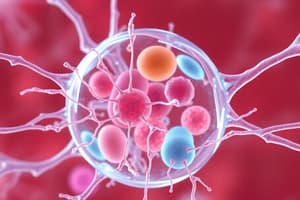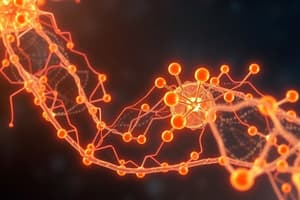Podcast
Questions and Answers
What structural feature allows microtubules to interact with motor proteins?
What structural feature allows microtubules to interact with motor proteins?
During cell migration, which cytoskeletal structure primarily promotes dynamic addition and subtraction?
During cell migration, which cytoskeletal structure primarily promotes dynamic addition and subtraction?
Which of the following statements accurately distinguishes actin filaments from microtubules?
Which of the following statements accurately distinguishes actin filaments from microtubules?
Which comparison is correct regarding the molecular basis of actin and microtubule dynamics?
Which comparison is correct regarding the molecular basis of actin and microtubule dynamics?
Signup and view all the answers
What happens to the length of myosin filaments during muscle contraction?
What happens to the length of myosin filaments during muscle contraction?
Signup and view all the answers
What triggers the addition of tubulin to the + end of microtubules?
What triggers the addition of tubulin to the + end of microtubules?
Signup and view all the answers
What is the primary function of actin filaments in relation to cell structure?
What is the primary function of actin filaments in relation to cell structure?
Signup and view all the answers
Which process increases during muscle contraction, specifically regarding the relationship between myosin and actin?
Which process increases during muscle contraction, specifically regarding the relationship between myosin and actin?
Signup and view all the answers
What is the primary role of microtubules in the cell?
What is the primary role of microtubules in the cell?
Signup and view all the answers
Which motor proteins are responsible for transporting cargo along microtubules?
Which motor proteins are responsible for transporting cargo along microtubules?
Signup and view all the answers
What is the effect of GTP/GDP on microtubules?
What is the effect of GTP/GDP on microtubules?
Signup and view all the answers
What structural feature differentiates actin filaments from microtubules?
What structural feature differentiates actin filaments from microtubules?
Signup and view all the answers
Which component of the cytoskeleton is specifically known for resisting rupture from stretching?
Which component of the cytoskeleton is specifically known for resisting rupture from stretching?
Signup and view all the answers
Which of the following best describes the structure of a lipid bilayer?
Which of the following best describes the structure of a lipid bilayer?
Signup and view all the answers
What percentage of the test questions emphasize the topic of 'What & why/how'?
What percentage of the test questions emphasize the topic of 'What & why/how'?
Signup and view all the answers
How are organelles positioned within the cell?
How are organelles positioned within the cell?
Signup and view all the answers
What type of receptor is used by steroid signals?
What type of receptor is used by steroid signals?
Signup and view all the answers
How does the mechanism of action of protein signals differ from that of steroid signals?
How does the mechanism of action of protein signals differ from that of steroid signals?
Signup and view all the answers
Which statement accurately describes how intracellular signaling differs during fast versus slow cell responses?
Which statement accurately describes how intracellular signaling differs during fast versus slow cell responses?
Signup and view all the answers
What is a primary mechanism through which protein molecular switches are activated?
What is a primary mechanism through which protein molecular switches are activated?
Signup and view all the answers
What role do second messengers play in cellular signaling?
What role do second messengers play in cellular signaling?
Signup and view all the answers
In the context of receptor tyrosine kinases (RTKs), what is one major consequence of their activation?
In the context of receptor tyrosine kinases (RTKs), what is one major consequence of their activation?
Signup and view all the answers
What process involves the alteration of protein function through covalent modifications?
What process involves the alteration of protein function through covalent modifications?
Signup and view all the answers
What is a consequence of crosstalk between signal transduction pathways?
What is a consequence of crosstalk between signal transduction pathways?
Signup and view all the answers
What is the ratio of concentrations of positively charged ions outside and inside the cell when the membrane potential is -60 mV?
What is the ratio of concentrations of positively charged ions outside and inside the cell when the membrane potential is -60 mV?
Signup and view all the answers
Which type of ion channel opens at approximately -40 mV?
Which type of ion channel opens at approximately -40 mV?
Signup and view all the answers
What are the three general types of gated ion channels?
What are the three general types of gated ion channels?
Signup and view all the answers
Why is the membrane potential of a neuron typically negative?
Why is the membrane potential of a neuron typically negative?
Signup and view all the answers
What initiates the release of calcium ions from the sarcoplasmic reticulum?
What initiates the release of calcium ions from the sarcoplasmic reticulum?
Signup and view all the answers
Which neurotransmitter connects nerves to muscles at neuromuscular junctions?
Which neurotransmitter connects nerves to muscles at neuromuscular junctions?
Signup and view all the answers
What is the role of signal sequences in protein transport?
What is the role of signal sequences in protein transport?
Signup and view all the answers
What drives the recycling of nuclear import receptors?
What drives the recycling of nuclear import receptors?
Signup and view all the answers
What initiates the process that allows myosin to bind to actin during muscle contraction?
What initiates the process that allows myosin to bind to actin during muscle contraction?
Signup and view all the answers
What effect does the absence of ATP have on the myosin head?
What effect does the absence of ATP have on the myosin head?
Signup and view all the answers
Which of the following steps is not part of the pathway for muscle contraction?
Which of the following steps is not part of the pathway for muscle contraction?
Signup and view all the answers
What role does cholesterol play in the lipid bilayer?
What role does cholesterol play in the lipid bilayer?
Signup and view all the answers
What is the primary structure that reduces the diffusion of membrane proteins?
What is the primary structure that reduces the diffusion of membrane proteins?
Signup and view all the answers
Which process contributes to organizing lipids in the endoplasmic reticulum during lipid synthesis?
Which process contributes to organizing lipids in the endoplasmic reticulum during lipid synthesis?
Signup and view all the answers
What occurs to tropomyosin when calcium ions bind to troponin?
What occurs to tropomyosin when calcium ions bind to troponin?
Signup and view all the answers
How do phospholipids contribute to the formation of the lipid bilayer?
How do phospholipids contribute to the formation of the lipid bilayer?
Signup and view all the answers
Study Notes
Cytoskeleton: Components
- Intermediate filaments resist rupture (stretching)
- Nuclear lamina supports nuclear membrane and positions chromatin
-
Microtubules are highways of the cell:
- GTP/GDP controls the dynamic instability of microtubules
- Kinesin and dynein motor proteins transport cargo along microtubules
- transport organelles to position them in the cell
- cilia and flagella for cell motility
-
Actin filaments allows stability or changes in cell shape:
- Functions: cell shape, movement, migration
-
Microtubules and Actin filaments use similar formation mechanisms:
- + / - ends
- Small molecules (allosteric regulation of protein)
- Covalent modifications of small molecules (hydrolysis and condensation)
Cytoskeleton: Muscle Contraction
- Sarcomere: a complex of myosin and actin
- Nervous system signaling of T-tubules promotes release of calcium ions from the sarcoplasmic reticulum
- Tropomyosin blocks the myosin binding site on actin
-
Myosin:
- a motor protein that uses ATP hydrolysis to move
- ATP binding: allosteric regulation
- ATP hydrolysis: covalent modification
-
Steps to expose actin to myosin binding:
- Electrical signal from nerve
- Signal transfer to T-tubules
- Calcium ion release from sarcoplasmic reticulum
- Calcium binding to troponin
- Troponin conformational change pulls tropomyosin off binding site
- Myosin head binds to actin
-
Myosin head conformation and muscle contraction:
- No ATP: myosin head bound to actin and contracted (muscle contracts)
- ATP: myosin head releases from actin, still contracted (muscle relaxed)
- ADP + Pi: myosin head relaxes (muscle relaxed)
- ADP: myosin head bound to actin, relaxed (muscle relaxed)
Membranes: Structure
- Phospholipids are amphipathic
- Lipid bilayer is formed by these amphipathic lipids
-
Molecules in the lipid bilayer are dynamic (2D fluid)
- Cholesterol slows down dynamic lipid flow
- ER has scramblase that randomizes lipids, other membranes have flippase to organize them
- Transmembrane proteins have different functions
Membranes: Transporters
- Transmembrane proteins fold differently than cytoplasmic proteins
- Detergents are amphipathic and disrupt membranes
- Cell cortex supports the cell membrane in animals
-
Methods to limit membrane protein diffusion:
- Anchor to cell cortex
- Anchor to external protein
- Anchor by binding to another cell’s protein
- Diffusion barriers
Membranes: Ion Channels
- Nernst equation: V = 62 LOG10 (CO/CI)
- Potassium leak channel is an example of an ion channel
-
Gated ion channels
- Voltage-gated Na+ and K+ channels are important for action potentials
-
Neuron:
- Sodium-Potassium pump maintains a non-zero membrane potential (negative inside cell)
-
Action potential:
- Na+ channel opens ~ -40mV, closes ~ +40 mV
- K+ channel opens ~+40 mV, closes ~-40mV
-
Synaptic cleft:
- Electrical signal gets converted to a chemical signal
- Neurotransmitters are extracellular ligands for ligand-gated ion channels
- Neurotransmitters can be either excitatory (+) or inhibitory (-)
-
Neuromuscular junction (NMJ):
- Acetylcholine is the neurotransmitter
- Neurons connect to T-tubules at the NMJ
- Change in voltage of T-tubules promotes release of calcium ions from the sarcoplasmic reticulum
Intracellular: Organelles
- Organelles are not to scale in diagrams
- Signal sequences enable protein localization
-
Three general mechanisms of protein transport:
-
Nuclear pore complex
- GTP/GDP modulation of Ran for nuclear import receptor recycling
- Protein translocators unfold proteins for transport across membranes
-
ER protein translocator ties to protein synthesis (rough ER)
- Signal recognition particle (SRP) localizes proteins to the rough ER
-
Nuclear pore complex
Signaling: General Principles
-
Different signal molecules require different types of receptors
- Proteins = extracellular
- Steroids = intracellular
- One signal molecule can induce many different responses depending on the target cell
- Combination of signals each cell receives dictates cell function
- Cell response can be fast or slow
Signaling: Receptors
- G-protein-coupled receptors (GPCRs) share similar structure
-
General GPCR mechanism:
- Ligand binding activates the receptor
- Activated receptor binds to a G protein
- G protein exchanges GDP for GTP
- Activated G protein subunit dissociates and interacts with target proteins
- Activated G protein subunits can directly regulate target proteins or covalently modify second messengers
- Second messengers can alter protein function or gene expression
- Inositol phospholipid pathway: another second messenger pathway
-
Receptor tyrosine kinases (RTKs): an example of enzyme-coupled receptors
- Covalent modifications (phosphorylation) lead to allosteric regulation
- One RTK can activate many different pathways
- Multiple signal transduction pathways interact through cross-talk
Studying That Suits You
Use AI to generate personalized quizzes and flashcards to suit your learning preferences.
Related Documents
Description
Explore the intricate details of the cytoskeleton in this quiz, covering components such as intermediate filaments, microtubules, and actin filaments. Understand their roles in cellular structure and muscle contraction as well as the mechanisms involved in these processes.





